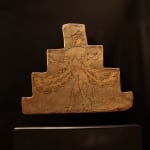Assyrian Glazed Brick Tile Depicting a Mythological Creature, 900 BCE - 700 BCE
Glazed Terracotta
height 55.2 cm
height 21 3/4 in
height 21 3/4 in
X.0262
Further images
Although archaeological excavations reveal that the land of the Assyrians had been inhabited as early as 5000 B.C., it was not until the reign of King Sargon of Akkad in...
Although archaeological excavations reveal that the land of the Assyrians had been inhabited as early as 5000 B.C., it was not until the reign of King Sargon of Akkad in 2371 B.C. that the Assyrians first rose to glory. Under Sargon, the kingdom rapidly expanded north to the city of Ashur and as far west as the Mediterranean, controlled by a central government based in Akkad. By 1813 B.C., King Shamshi-Adad I united the cities of Ashur, Nineveh, and Arbel into one cohesive administrative unit. These three cities, as well as Arrapkha and Kalhu (later known as Nimrud), form the historical core of the Assyrian Kingdom which would remain a credible force throughout the Mediterranean world for the next millennium. While various parts of Assyrian territory were annexed for brief periods of time by neighboring civilizations, this core remained firmly intact. The Assyrians experienced another Golden Age, lasting from the 9th until the 7th Century B.C. (this period is referred to as “Neo-Assyrian”). During this period, the kingdom grew to its largest extent, encompassing the lands from parts of modern Iran to the Mediterranean, from Anatolia to Egypt. However, it proved difficult even for the powerful Assyrian monarchs to maintain control over this vast territory for very long. By the end of the 7th Century, the Assyrian Kingdom began to collapse under the weight of assaults from the Babylonians to the south and the newly founded Medes Kingdom to the east. In 612 B.C., Nimrud burned for the second time in three years, followed by the sacking of Ashur and Nineveh, effectively ending Assyrian control of the ancient Near East.
Sparse expanses of monochromatic hues are a product of minimalism and modernity. The great palaces and temples of ancient Greece and Rome might seem like elegant precursors; however, time and the elements have erased the elaborate paintings and decorations that once colored the most intricate details, both architectural and sculptural. Throughout the past, great civilizations have decorated their constructions with sumptuous paintings and tiles. Many remarkable examples survive today from the wall paintings and mosaics of Pompeii to the glazed tiles of the Ishtar Gate in Babylon.
The tradition of glazed terracotta brick as adornments began in southern Iran in the 13th century B.C. This Assyrian glazed brick tile would have adorned the walls of a temple or palace structure. The tiered tile is decorated by the representation of a mythological creature based on the forms of a female human. However, this woman is winged and has the arms of a lion. A slight relief of a brown glaze delineates the outlines of her body as well as the simulated feathers of the wings. A headband crowns her head and her curly lucks fall over the back. Seen in profile, her one ovular eye is fully open and alert. The musculature of her body, specifically her arms and ribcage, has been indicated by a series of gently curing arches. Her lion paw arms reach outward, as if pushing against the borders of the brick. This fantastical remnant of a lost age reveals the extreme sophistication and elegance of the Assyrian civilization.
Sparse expanses of monochromatic hues are a product of minimalism and modernity. The great palaces and temples of ancient Greece and Rome might seem like elegant precursors; however, time and the elements have erased the elaborate paintings and decorations that once colored the most intricate details, both architectural and sculptural. Throughout the past, great civilizations have decorated their constructions with sumptuous paintings and tiles. Many remarkable examples survive today from the wall paintings and mosaics of Pompeii to the glazed tiles of the Ishtar Gate in Babylon.
The tradition of glazed terracotta brick as adornments began in southern Iran in the 13th century B.C. This Assyrian glazed brick tile would have adorned the walls of a temple or palace structure. The tiered tile is decorated by the representation of a mythological creature based on the forms of a female human. However, this woman is winged and has the arms of a lion. A slight relief of a brown glaze delineates the outlines of her body as well as the simulated feathers of the wings. A headband crowns her head and her curly lucks fall over the back. Seen in profile, her one ovular eye is fully open and alert. The musculature of her body, specifically her arms and ribcage, has been indicated by a series of gently curing arches. Her lion paw arms reach outward, as if pushing against the borders of the brick. This fantastical remnant of a lost age reveals the extreme sophistication and elegance of the Assyrian civilization.









